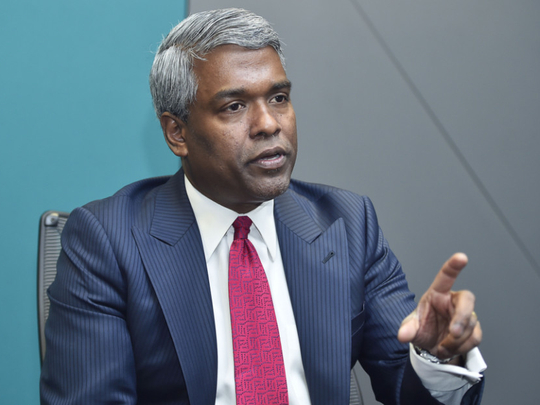
Dubai
Oracle is strengthening its cloud offerings to gain an upper hand over rivals and differentiate from the crowd.
Thomas Kurian, president of product development at Oracle, told Gulf News that the company is applying artificial intelligence and machine learning to its cloud offerings in a bid to help customers lower cost, cut risk, accelerate innovation and get predictive insights.
Moreover, he said that Oracle will be the only cloud provider to offer enterprise service-level of 99.95 per cent on infrastructure security.
“If we don’t meet that, we will take penalties. It is because of the design of what we do for reliability. Other vendors offer no guarantees around performance. Enterprise customers require critical business applications to perform at consistent and reliable levels,” he said.
He added that this is the fourth phase of growth for the company. The first phase was when the company was founded till 1991 where it was primarily a database company. From 1991 to 2004, the company evolved into database and applications. Starting 2004, the company introduced middleware, analytics and a full-fledged technology provider.
“Also at the same time, we are acquiring companies. The fourth phase is the cloud. If you look at the booking sizes each year, PaaS [platform as a service] and IaaS [infrastructure as a service] have the same size as SaaS [software as a service]. We were in the SaaS three years before IaaS and PaaS,” he said.
Today, he said that 60 per cent comes from technology business and 40 per cent from applications. Within the next five years, it is expected to become 50 per cent each.
On a total company basis, he said that Oracle is larger than Google in the cloud revenues. A lot of Amazon and Microsoft depends on how quickly they scale out on data centre locations.
“Our offerings are quite different from Amazon and Microsoft. We offer SaaS and they don’t. We offer a complete autonomous set of PaaS while Amazon uses a set of tools to automate certain elements of managing database. Our PaaS technology has eight elements — data management, application development, analytics, big data, mobility, integration, system management, identity and security.
In IaaS, our big difference is three — faster [three to seven times], security, scalability and reliability,” he said.
Enterprise resource planning, sales and apps come under SaaS (software-as-a-service) while authoring tools, databases, Java, IoT and analytics come under PaaS (platform-as-a-service), and infrastructure layer, physical servers, storage and data centres come under IaaS (infrastructure-as-a-service).
The US company is expanding its cloud footprint in China, India, Japan, Saudi Arabia, Singapore, South Korea, Amsterdam, Switzerland, Canada and two new US locations to support US Department of Defence workloads.
Kurian said that one of the key barriers to cloud adoption for many countries is due to the lack of data centre availability in that country. Today, many countries have data residency requirements which means that data has to reside in that country.
The US company is going to open the Abu Dhabi date centre between May and August.
Kurian said the future of tomorrow’s successful enterprise IT organisation is autonomous and at Oracle, “we are making this a reality. We are weaving autonomous capabilities into the fabric of our cloud to make it self-administering in a bid to help customers safeguard their systems and deliver real-time decisions.”
He said that Mitsubishi is building a factory with the company. In the digital factory, all equipment are equipped with sensors. As the factory runs, they use Oracle’s IoT technology to do predictive maintenance as well as if the factory stops, they are quickly able to see the impact on the supply chain. “We are introducing voice technology to talk to applications. AI is the next evolution of software, it is just algorithms that do things that today is done traditionally using things like rules. But just like any other technology coming into the market, there are risks with AI and people need to know how to manage the risks,” he said.
If your algorithm is poorly written and starts to have issues, then you will have a problem. Any labour intensive industry which is going through digitisation will have a major impact from AI, he said.
For example, before ERP, all processes in organisations were paper-based. When ERP was introduced in 1990s, the statement was that a lot of people were going to lose their jobs because of electronification of all corporate business processes. In reality, it created more jobs than people losing their jobs.










